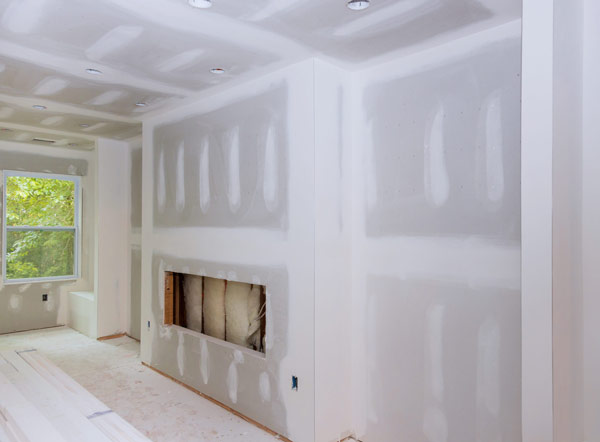A Comprehensive Overview to Mastering Drywall Fixing and Installation
This guide provides an extensive exploration of drywall repair and installation, providing to both newbies and experienced experts. It details vital tools, methods for patching and hanging sheets, and the important finishing procedures. drywall contractor. By recognizing usual pitfalls, people can attain refined outcomes. Grasping these skills not only enhances one's home but likewise develops confidence in DIY ventures. What foundational pointers will assure an effective job throughout?
Crucial Devices for Drywall Repair and Installation
When beginning on drywall repair and installment, a few essential devices can substantially boost the efficiency and high quality of the work. A drywall knife, generally available in various dimensions, is crucial for using joint substance and smoothing seams. A taping knife is additionally needed for feathering edges and making certain a seamless finish. In addition, a drywall saw or utility blade permits specific cutting of drywall sheets to fit any kind of space.

Step-by-Step Guide to Patching Holes
Patching holes in drywall is a simple process that can restore the wall surface's look and honesty. To start, the location around the opening ought to be cleaned and any type of loosened particles got rid of. For little holes, an easy spackle or joint compound can be applied with a putty knife. Larger openings may require a patch; an item of drywall can be reduced to fit the hole, secured with glue or screws, and after that taped around the edges. When the spot is in place, joint compound is applied over the patch and feathery out to mix with the bordering wall. After the compound dries, sanding is essential to accomplish a smooth surface. Finally, the fixed area can be primed and painted to match the remainder of the wall. This technique guarantees a smooth repair service, improving the general appearance of the drywall and keeping its architectural stability.
Methods for Hanging Drywall Sheets
After effectively fixing holes in drywall, the following action entails hanging new drywall sheets to develop a smooth surface area. To achieve this, one have to start by measuring the wall space precisely and cutting the drywall sheets to fit. It is crucial to hang the sheets flat for better structural integrity, starting from the top and working downwards.
Utilizing a drywall lift can streamline the process, specifically for ceiling installments. Once positioned, safeguarding the sheets with drywall screws at intervals of regarding 12 inches along the edges and 16 inches in the field is essential. This guarantees a strong hold and lowers the risk of drooping. For edges, the sheets ought to be cut to fit snugly, permitting cleaner seams. Ultimately, it is suggested to startle the joints between sheets to reinforce the overall structure, producing a much more long lasting finish ready for the following phase in the drywall installation process.
Completing Touches: Insulation and Mudding
Finishing the drywall setup includes the vital actions of mudding and taping, which ensure a polished and smooth coating. Insulation calls for the application of joint tape over the seams in between drywall sheets. drywall contractor. This tape can be visit the site either paper or fiberglass fit together, with each kind offering one-of-a-kind benefits. After taping, the following action is mudding, where joint compound, or "mud," is put on cover the tape and load any type of blemishes
Utilizing a drywall knife, the substance needs to be spread uniformly, ensuring a feathery side to minimize noticeable adjustments. Multiple coats are often essential, with sanding in between each layer to achieve a smooth surface. Careful attention during this procedure is vital, as it significantly impacts the last look of the wall. With the right strategy and perseverance, completion outcome will be a remarkable structure ready for painting or ending up touches.
Usual Blunders to Stay Clear Of in Drywall Projects

Another usual mistake is not enabling enough drying time in between coats, which can trap dampness and compromise the coating. Furthermore, neglecting to feather the edges properly can produce noticeable lines and flaws. Finally, missing sanding or making use of incorrect methods might leave rough spots. By knowing these challenges, individuals can significantly improve the high quality of their drywall jobs and accomplish a professional-looking finish.
Regularly Asked Inquiries
Can I Repair Drywall Without Specialist Aid?
Yes, one can fix drywall without expert aid. With the right tools, materials, and support, people can successfully manage minor repair services. Nonetheless, substantial click for source damage might call for expert know-how for excellent results and toughness.
For How Long Does Drywall Substance Require To Dry?
Drywall compound commonly takes in between 24 to 2 days to completely dry completely, depending on aspects such as humidity and temperature level. Thinner layers may dry quicker, while thicker applications call for more time for excellent outcomes.
What's the most effective Sort Of Paint for Drywall?
The most effective kind of paint for drywall is usually a water-based latex paint. It gives outstanding coverage, resilience, and ease of application, making it ideal for interior wall surfaces while permitting for easy cleanup with soap and water.

Just how Do I Avoid Mold And Mildew on Drywall?
To stop mold try here and mildew on drywall, warranty proper ventilation, control moisture levels, use mold-resistant products, and without delay address any leakages. Routine examinations and immediate removal of water damage are additionally necessary for lasting avoidance.
Is Drywall Recyclable After Elimination?
Drywall is recyclable after elimination, supplied it is without impurities like mold, paint, or various other harmful products. Reusing facilities can refine it right into brand-new items, advertising sustainability and lowering landfill waste in building.
When beginning on drywall repair service and installment, a couple of necessary tools can significantly boost the performance and high quality of the work. After efficiently fixing openings in drywall, the following action includes hanging brand-new drywall sheets to develop a seamless surface. Completing the drywall installation involves the vital steps of mudding and taping, which guarantee a refined and smooth coating. Accomplishing a polished finish in drywall tasks can be tough, and several typical mistakes can undermine the high quality of the work. Yes, one can fix drywall without professional assistance.